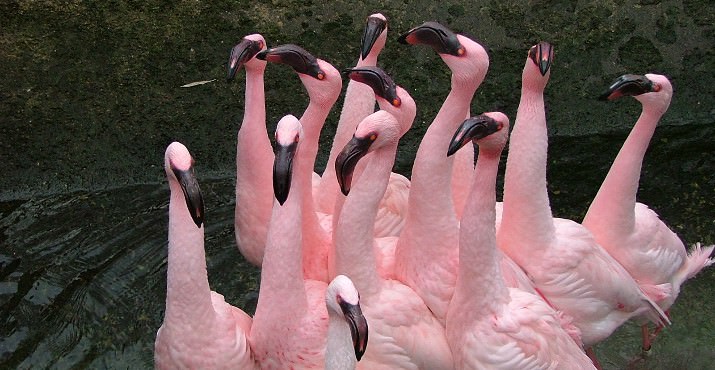Flamingo Flock Landing at the Oregon Zoo


Flamingo flock headed to the Oregon Zoo
Portand, February 12th, 2013. The newest residents of the Oregon Zoo will be pretty in pink. This month, 21 lesser flamingos arrived from the San Antonio Zoo. After about a month of acclimation and observation to ensure the birds’ health, the flamingos will wade into their home in the newly remodeled Africa Rainforest aviary.
The pink birds will meet the public March 23 at the reopening of the Africa Rainforest aviary, which has been closed for remodeling since November. The flamingos’ new home boasts a pool especially designed for them, a new nesting area, and separate holding areas for the flamingos and for the ducks, pochards and ibises that share the aviary.
Northwesterners may not be used to seeing pink flamingos — except for the lawn variety. The birds have not been part of the Washington Park landscape since the early 1950s, when three flamingos were given to the zoo by the Meier & Frank Co.
It’s fitting that this flock will make its Oregon Zoo debut just in time for spring break, since flamingos often put people in mind of Miami and other getaway destinations. But animal curator Michael Illig hopes the aviary’s flamboyant newcomers help visitors think of the lake regions of eastern Africa, where most of the world’s lesser flamingos are born.
“The flamingo is such a gorgeous, social bird,” Illig said. “When people make a connection with the flamingo, they become curious about where the birds come from and the challenges they face in the wild.”
The smallest species of flamingo, the lesser flamingo (Phoenicopterus minor) stands nearly 3 feet tall and weighs 3 to 6 pounds, with a wingspan up to 41 inches. The Oregon Zoo’s lesser flamingos come to Portland from the San Antonio Zoo, which is phasing out its flock. All of the flamingos are males, but Illig says the zoo plans to add females and begin a reproductive program in the future. The zoo’s flamingo population will be managed under a cooperative program of the Association of Zoos and Aquariums, of which the Oregon Zoo is an accredited member.
With a global population of more than 2 million, the lesser flamingo is not considered an endangered species. There is cause for concern, though: Some of the birds’ main breeding sites are facing risks due to industrial pollution and human encroachment.
The primary habitats of the lesser flamingo are shallow, brackish lakes in the Rift Valley of eastern Africa, where three-quarters of the population is born. A smaller population lives in India. The birds have specialized salt glands that allow them to excrete excess salt they ingest, letting them take advantage of habitats other animals cannot.
Lesser flamingos feed on spirulina, a blue-green bacteria, which thrives in alkaline lakes and contains the photosynthetic pigments that give the birds their pink color. At the Oregon Zoo, the flamingos will eat a specialized diet that contains the algae they need. They’ll scoop food out of the lagoon in much the same way they do in the wild, dipping their beaks upside-down into the water and sweeping them back and forth to filter food.
The Africa Rainforest lagoon renovation is part of a larger, donor-funded aviary upgrade project. Cascade Marsh, in the Great Northwest habitat area, is also reopening after renovation that included new netting, a new vestibule and pole caps to preserve the aviary structure.
The aviary upgrades are part of an effort to improve habitats, enhance animal welfare and make the grounds more sustainable, but these renovations were not funded by the zoo bond measure passed by voters in 2008. The aviary improvements were funded entirely by donor contributions through the Oregon Zoo Foundation.
The zoo is a service of Metro and is dedicated to its mission of inspiring the community to create a better future for wildlife. Committed to conservation, the zoo is currently working to save endangered California condors, Oregon silverspot and Taylor’s checkerspot butterflies, western pond turtles and Oregon spotted frogs. Other projects include studies on Asian elephants, polar bears, orangutans and giant pandas. Celebrating 125 years of community support, the zoo relies in part on donations through the Oregon Zoo Foundation to undertake these and many other animal welfare, education and sustainability programs.
The zoo opens at 10 a.m. daily and is located five minutes from downtown Portland, just off Highway 26. The zoo is also accessible by MAX light rail line. Visitors who travel to the zoo via MAX receive $1.50 off zoo admission. Call TriMet Customer Service, 503-238-RIDE (7433), or visit www.trimet.org for fare and route information.
Information provided by the Oregon Zoo’s Hova Najarian
Recent Posts
2025 Portland Rose Festival Plans are Set
Portland, OR. The Portland Rose Festival has inspired the public to gather and celebrate against…
Portland Art Museum Exhibit Will Highlight Contemporary Art from the Collections of Jordan D. Schnitzer
Portland, OR. Opening in September 2025, the Portland Art Museum (PAM) presents Global Icons, Local Spotlight:…
VIPs Gearing up for Classic Wines Foundation Gala
Portland, OR. Organizers say the "Salon de Vin" benefit for Classic Wines is shaping up.…
Diamonds & Denim Gala Will Benefit The Links, Inc.
Portand, OR. The Portland Chapter of The Links, Incorporated, and the White Rose Educational Foundation…
Nonprofits Honored as Providence Health Plan Celebrates 40th Anniversary
Portland, OR. Providence Health Plan recently celebrated its 40th anniversary with a totally rad 1980’s…
Oregon Historical Society Hosts History Makers Gala
Portland, OR. The Oregon Historical Society’s (OHS) annual Oregon History Makers Awards & Dinner recognizes…


